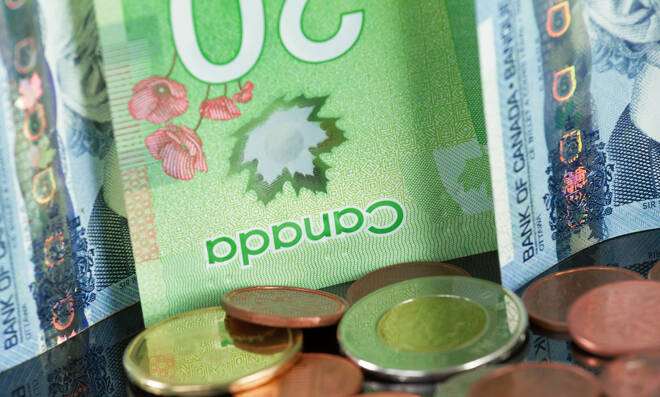Advertisement
Advertisement
USD/CAD: Loonie Weakens on Lower Oil Prices, Firm Greenback
By:
“Having the lowest volatility among G10 commodity currencies, CAD may emerge as a popular carry bet against low-yielders next year. We think CAD has the lowest downside risk in the commodity FX space and expect USD/CAD to stay closer to 1.20 rather than to 1.25 in 2022,” noted Francesco Pesole, FX Strategist at ING.
The Canadian dollar weakened slightly against its U.S. counterpart on Wednesday as crude oil prices fell and the greenback hovered close to the 16-month high on increasing bets that the Fed would raise interest rates sooner than previously thought.
“The Bank of Canada shifted to a more hawkish stance in October by ending QE and signalling a first hike should come in 2Q22 or 3Q22. Markets are currently pricing in the first hike at the March meeting and see a total of 125bp of tightening in 2022. We currently forecast four 25-bp rate hikes in 2022, so expect only limited scope for a re-pricing of tightening expectations,” noted Francesco Pesole, FX Strategist at ING.
“Having the lowest volatility among G10 commodity currencies, CAD may emerge as a popular carry bet against low-yielders next year. We think CAD has the lowest downside risk in the commodity FX space and expect USD/CAD to stay closer to 1.20 rather than to 1.25 in 2022.”
Today, the USD/CAD pair rose to 1.2586 up from Tuesday’s close of 1.256. After gaining about 2.3% last month, the Canadian dollar strengthened over 1.3% so far this month.
The dollar index, which measures the value of the dollar against six foreign currencies, was trading nearly flat at 95.863. Last week, the greenback rose to 16-month highs against most other major currencies because of the hottest U.S. inflation reading in a generation that pushed investors to bet that interest rates are likely to rise sooner than previously thought.
In October, U.S. consumer prices rose faster than expected due to surges in gasoline and food prices, showing that inflation could remain high well into next year amid snarled global supply chains. Labor Department data on Wednesday showed that the consumer price index rose 0.9% last month after rising 0.4% in September. In the 12 months through October, the CPI increased 6.2% up from September’s 5.4% increase.
It is highly likely that the world’s dominant reserve currency, the USD, will rise by end of the year, largely due to the expectation of at least one rate hike next year. With the dollar strengthening and a possibility that the Federal Reserve will raise interest rates earlier than expected, the USD/CAD pair may experience a rise.
“The dollar index (DXY) may bid on front-end rate differentials especially vs funders (EUR, JPY, CHF) but with sharp DXY gains unlikely as the UST curve flattens, signalling market conviction that any Fed tightening is likely to be shallow,” added Citi analysts.
“This would still leave US financial conditions accommodative which limits the extent of DXY gains. DXY is so far sustaining above strong resistance at 94.65-83 that has held for the last seven weeks. The weekly close above now brings the double bottom pattern back in to play and suggests extended gains towards 97.50.”
Canada is the world’s fourth-largest exporter of oil, which edged lower on easing supply concerns. At the time of writing, U.S. West Texas Intermediate (WTI) crude was trading 0.77% lower at $80.13 a barrel. Lower oil prices lead to lower U.S. dollar earnings for Canadian exporters, resulting in a decreased value of the loonie.
“We expect oil to average 76$/bll (Brent) in 2022, with a gradual return to surplus driving prices moderately lower. Such a gradual downtrend should not be enough to undermine the recovery in the Canadian oil and gas industry, currently, a major driver of economic strength,” ING’s Pesole added.
“Being a very open economy, Canada is also set to benefit from the further recovery in global trade, which could accelerate in 2H22 as supply strains ease. As 70% of Canada’s exports head to the US, long-CAD should continue to be a proxy trade for the strong US growth story.”
About the Author
Vivek Kumarauthor
Vivek has over five years of experience in working for the financial market as a strategist and economist.
Advertisement
